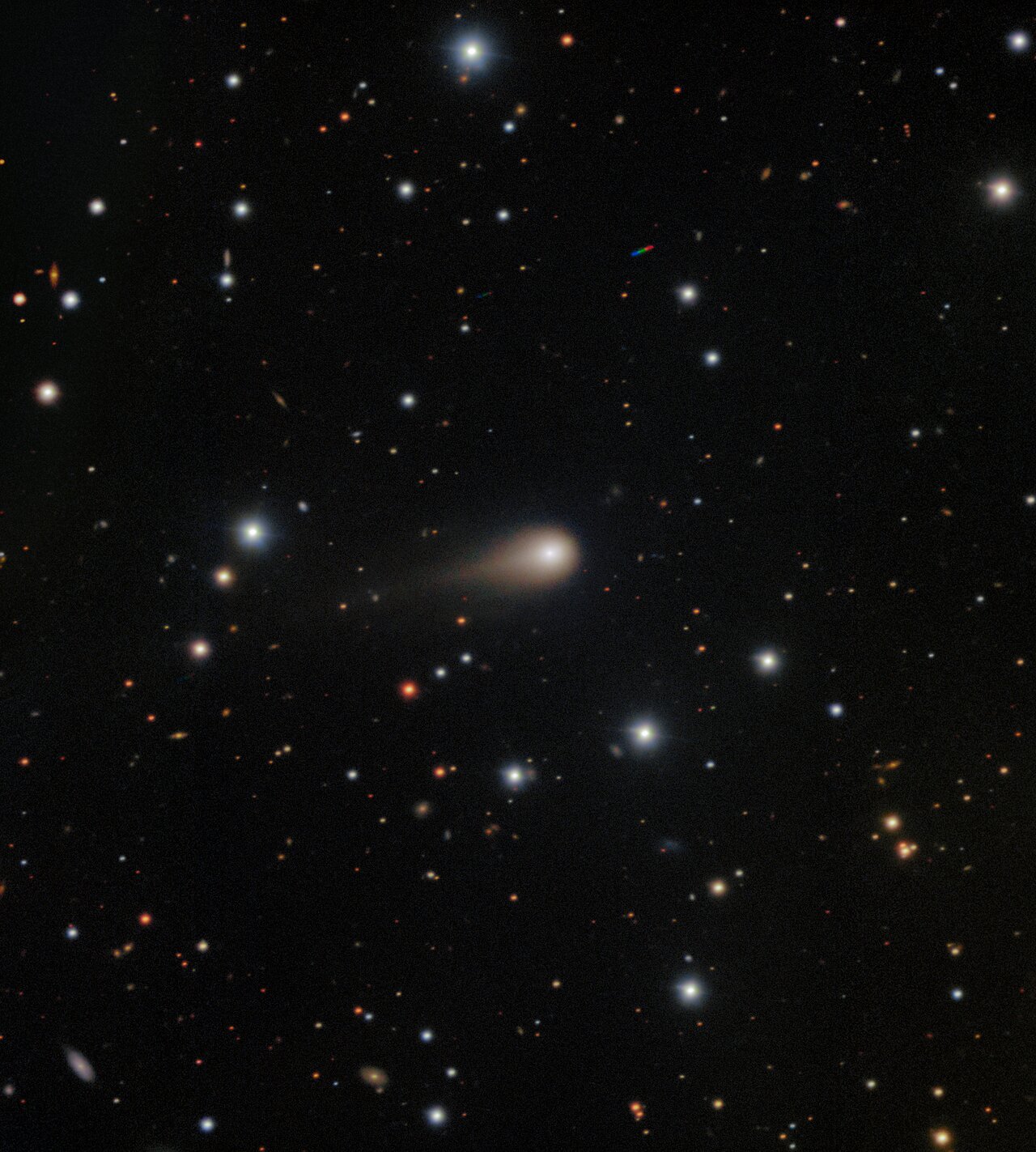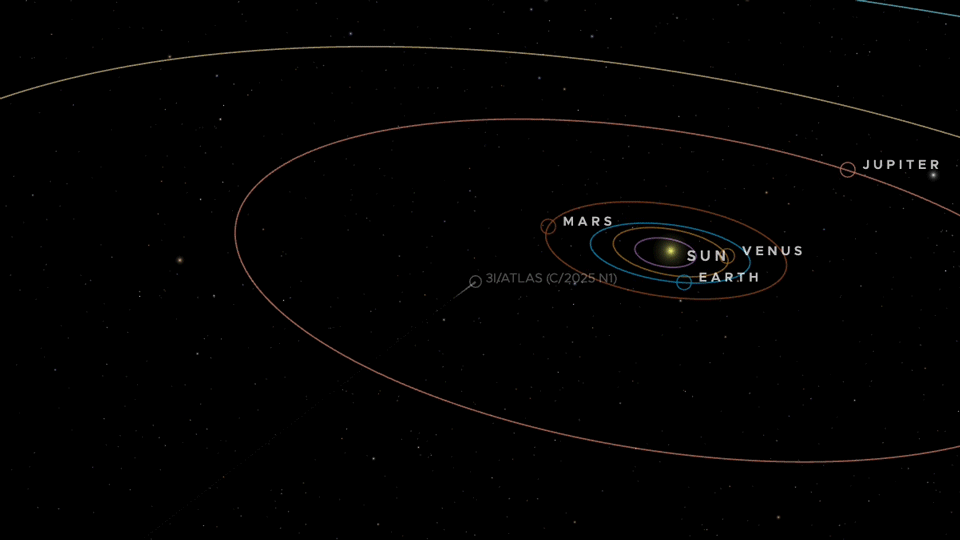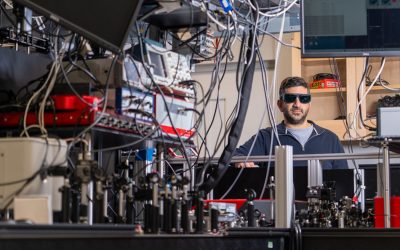The Europa Clipper spacecraft is poised for an imminent encounter with charged particles, likely to be pummeled by matter violently ripped from the ion tail streaming off the interstellar comet 3I/ATLAS.
Two European researchers have made a groundbreaking prediction, leveraging sophisticated computer code to identify precise moments when a spacecraft can achieve a perfect alignment with a comet’s tail and the sun. This rare celestial phenomenon, which poses absolutely no threat to the spacecraft, offers an exceptionally fortuitous cosmic convergence. More significantly, it presents an unprecedented opportunity to directly sample material from a comet originating from beyond our region of the cosmos.
“We currently have extremely limited insight into the interior of interstellar comets and the distant star systems where they originated,” Samuel Grant of the Finnish Meteorological Institute, who spearheaded the recent research, explained to Space.com. He emphasized that by analyzing the material shed from a comet’s tail, scientists achieve the closest possible approximation to a direct sample of these elusive cosmic objects. This method, Grant added, offers a unique and invaluable window into a distinct region of our galaxy.

Despite a significant opportunity for NASA’s Europa Clipper to detect charged particles from Comet 3I/ATLAS, its ability to capitalize on this rare event faces a critical hurdle: the ongoing U.S. government shutdown.
The spacecraft, currently in cruise mode en route to Jupiter, has many of its scientific instruments deactivated. The optimal alignment for these crucial observations—between the Europa Clipper, the comet, and the sun—is scheduled for a narrow window between October 30 and November 6. If the government shutdown continues through this critical timeframe, it’s uncertain whether scientists will be permitted to activate the essential instruments for data collection, despite their readiness.
Should scientists successfully obtain these measurements, they stand to gain profound insights into the interstellar comet’s composition. This crucial data would then enable direct comparisons with comets native to our own solar system.
Comets are famously identified by their two distinct tails, structures that emerge as these icy wanderers draw closer to the sun. These luminous extensions are comprised of dust and various particles, actively released from the comet’s nucleus. The formation process is driven by increasing solar radiation, which significantly raises the comet’s surface temperature. This heat causes dormant pockets of gas just beneath the comet’s crust to expand dramatically and forcefully erupt, propelling both dust and other particles into the vastness of space.

The dust tail, often the most striking visual component of a comet, meticulously traces the celestial body’s exact path through space. Regrettably, no spacecraft is presently situated to penetrate the dust tail of comet 3I/ATLAS and acquire critical samples for analysis.
Here are a few options, maintaining a clear, journalistic tone and emphasizing the distinct nature of the ion tail:
**Option 1 (Direct and concise):**
“The ion tail, however, presents a distinct and separate phenomenon.”
**Option 2 (Emphasizing different dynamics):**
“In stark contrast, the ion tail operates under entirely different dynamics.”
**Option 3 (Highlighting unique characteristics):**
“Yet, the ion tail introduces a completely different set of characteristics and behaviors.”
**Option 4 (Focusing on separate consideration):**
“However, the ion tail demands a separate and specialized consideration.”
Cometary bodies are meticulously studied because they function as cosmic “time capsules,” preserving material sealed within them from their formation billions of years ago, Grant noted. Upon their approach to the sun, these comets eject some of this ancient matter. A fraction of these expelled particles is then swept away from the sun by the solar wind, forming the iconic ion tail.

Propelled by the solar wind—a continuous stream of charged particles emanating directly from the sun—the ion tail of a comet consistently points away from our star.
Between October 30 and November 6, the Europa Clipper spacecraft is poised for a critical window. During this period, it could be optimally positioned to potentially intercept a stream of solar wind ions—charged particles propelled towards the craft at velocities reaching several hundred miles per second.
Geraint Jones, the European Space Agency’s principal investigator for the Comet Interceptor mission, successfully predicted an ion tail crossing. Working with his colleague Grant, Jones utilized their innovative “Tailcatcher program”—a specialized computer code meticulously designed to track the movements of solar wind material packets, making such celestial forecasts possible.
According to Grant, researchers pinpoint the precise trajectory of incoming packets from the sun to a spacecraft by analyzing their velocity upon arrival. This reconstructed solar path is then critically compared against the comet’s known position.
Recent scientific calculations indicate that the Europa Clipper spacecraft could potentially encounter specific solar wind packets. These packets are believed to have passed close enough to a comet to actively strip away and carry off ions from its distinctive ion tail.
The solar wind, a constant outflow of particles from the sun, inherently carries its own stream of ions. This presents a critical challenge for scientists: how do they accurately distinguish these solar-origin ions from those that have been captured or “stolen” from a comet?
Cometary ions can be readily distinguished from the solar wind through several key indicators, according to Grant.
A primary method involves examining their chemical abundances. Unlike the solar wind, which is largely dominated by protons and helium, cometary ions contain significant amounts of heavier species, most notably “water-group ions.”
Beyond their composition, these ions also create a noticeable impact on their surroundings. The introduction of this additional mass from comets into the solar wind causes a measurable effect: a general slowing and deflection of the ambient solar wind’s flow.
Successful detection, particularly for missions like Europa Clipper, isn’t solely a matter of technological capability; it critically depends on the intrinsic nature and behavior of the solar wind itself. Primarily, the solar wind must be flowing in a precisely aligned direction. While this continuous stream of charged particles invariably originates from the Sun, its trajectory is not always perfectly radial. Occasionally, the solar wind can deviate, flowing at an angle, a scenario that could cause it to bypass the Europa Clipper spacecraft entirely.
For heavier ions to successfully reach the Europa Clipper spacecraft, the solar wind must possess adequate strength at precisely the right moment. The comet is set to achieve its perihelion—its closest approach to the sun—on October 29, positioning it a significant 126 million miles (200 million kilometers) from our star, which places it inside the orbit of Mars. Meanwhile, the Europa Clipper, having completed a Mars flyby earlier this year, is currently situated over 186 million miles (300 million kilometers) from the sun, highlighting the vast cosmic distances involved.
As Comet 3I/ATLAS continues its approach toward the sun, scientists anticipate a significant boost in its activity. This heightened cometary energy is projected to culminate at perihelion, when its ion tail is expected to achieve its broadest expanse. Such an expansion would substantially increase the likelihood of the Europa Clipper mission successfully detecting some of the comet’s constituent ions.
The European Space Agency’s Hera spacecraft, currently embarking on its journey to the double asteroid system of Didymos and Dimorphos, is slated for a fascinating celestial encounter. Between October 25 and November 1, Hera will find itself strategically positioned to intercept solar wind packets laden with cometary ions.
However, a significant limitation for Hera is its lack of specialized instruments capable of measuring the solar wind’s charged particles and magnetic field. Fortunately, NASA’s Europa Clipper mission *does* possess such capabilities. A core objective of Europa Clipper is to meticulously study Jupiter’s intense magnetic and radiation environment and its profound impact on its icy moon, Europa, making it ideally equipped for these precise measurements.
It is important to clarify that Grant and Jones are not integral members of the Europa Clipper team. As a result, they possess no decision-making authority concerning the methodology or even the undertaking of the team’s critical measurements.
Even if the Europa Clipper misses this opportunity, the Tailcatcher system boasts a strong record of accurately predicting ion tail crossings. Its past successes include forecasting the European Space Agency’s Solar Orbiter detection of ions from comet C/2019 Y4 in 2020. This proven capability ensures Tailcatcher will continue to be a crucial tool for identifying future tail crossings, potentially even for the next interstellar comet, whenever it may appear.
The fascinating and often unpredictable nature of comets is set to be explored with a novel approach by the European Space Agency. In 2029, ESA will launch its Comet Interceptor mission, a pioneering spacecraft designed with a unique strategy: rather than targeting a specific comet from the outset, it will hold its position in space until scientists identify a newly discovered comet deemed ideal for close-up study. High on the priority list for this unprecedented rendezvous are interstellar comets, offering a rare opportunity to examine objects originating from beyond our solar system.
The Comet Interceptor mission’s core objective is to execute an unprecedented close-range flyby of either an interstellar or a long-period comet, enabling the direct sampling of its coma and the nascent head of its tail. Grant, an expert not directly affiliated with the Interceptor project, underscored this primary goal. He further noted that a significant scientific advantage would arise if a separate spacecraft could concurrently traverse the upstream region of the comet’s tail.
The forecast by Grant and Jones regarding an impending ion tail crossing has been detailed in a pre-print, now accessible on the scientific repository arxiv.







